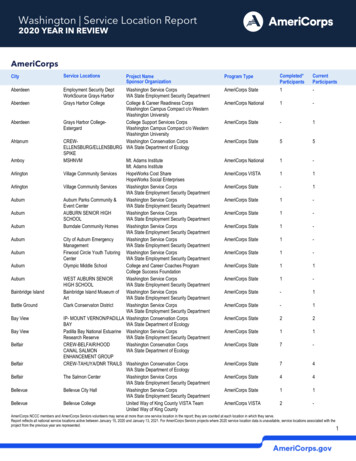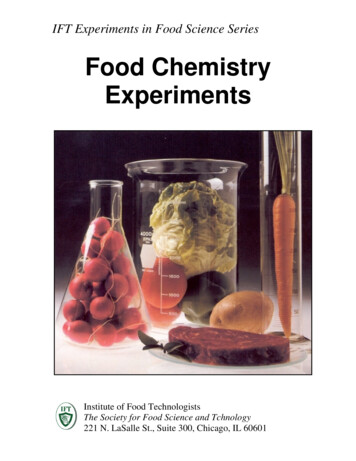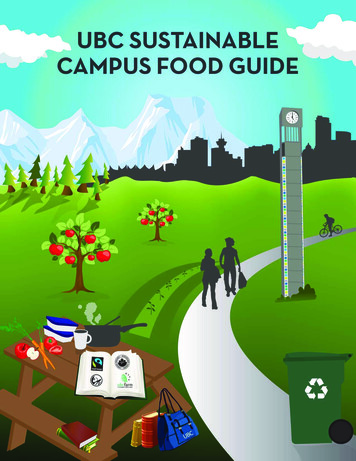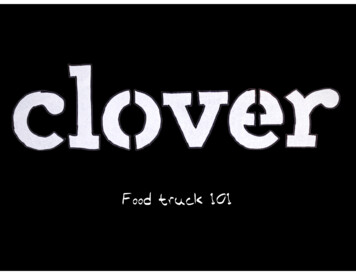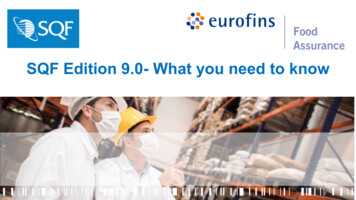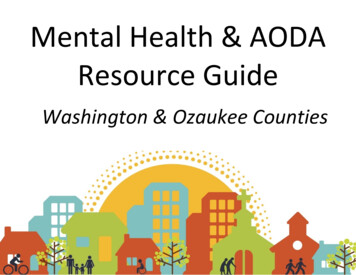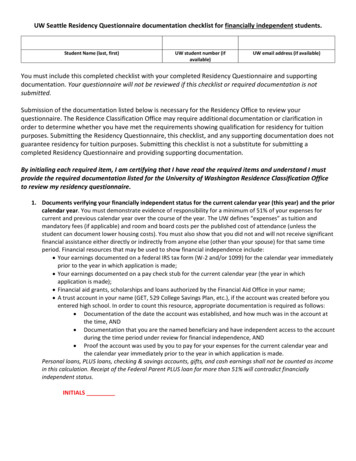
Transcription
Use Food Well Washington PlanA roadmap to a more resilient food systemthrough food waste reductionSolid Waste Management ProgramWashington State Department of EcologyHeadquartersOlympia, WashingtonFebruary 2022, Publication 21-07-027
Publication InformationThis document is available on the Department of Ecology’s website yPages/2107027.htmlContact InformationSolid Waste Management ProgramHeadquartersP.O. Box 47600Olympia, WA 98504-7600Phone: 360-407-6764Website 1: Washington State Department of EcologyADA AccessibilityThe Department of Ecology is committed to providing people with disabilities access toinformation and services by meeting or exceeding the requirements of the Americans withDisabilities Act (ADA), Section 504 and 508 of the Rehabilitation Act, and Washington StatePolicy #188.To request an ADA accommodation, contact Ecology by phone at 360-407-6900 or email atSWMpublications@ecy.wa.gov. For Washington Relay Service or TTY call 711 or 877-833-6341.Visit Ecology's website for more information.1www.ecology.wa.gov/contact
Department of Ecology’s Regional OfficesMap of Counties ServedRegionCounties servedMailing AddressSouthwestClallam, Clark, Cowlitz, Grays Harbor,Jefferson, Mason, Lewis, Pacific, Pierce,Skamania, Thurston, WahkiakumPO Box 47775NorthwestIsland, King, Kitsap, San Juan, Skagit,Snohomish, Whatcom15700 Dayton Ave. N.,Shoreline, WA 98133CentralBenton, Chelan, Douglas, Kittitas,Klickitat, Okanogan, Yakima1250 W Alder StEasternAdams, Asotin, Columbia, Ferry, Franklin,Garfield, Grant, Lincoln, Pend Oreille,Spokane, Stevens, Walla Walla, Whitman4601 N MonroeHeadquartersStatewideOlympia, WA 98504Union Gap, WA 98903Spokane, WA 99205PO Box 46700Olympia, WA 329-3400360-407-6000
Use Food Well Washington PlanA roadmap to a more resilient food systemthrough food waste reductionSolid Waste Management ProgramWashington State Department of EcologyOlympia, WARevised February 2022 Publication 21-07-027
Table of ContentsUse Food Well Washington Plan. 4List of Figures and Tables . 6Acknowledgements . 7Acronyms. 8Executive Summary . 9Use Food Well Washington Plan.11What is food waste?.11Why is food waste reduction important? .12How is Washington addressing food waste?.13Goals and Measurement.14How was the baseline data calculated?.14How can we monitor progress towards food waste reduction goals? .16Strategies.17Recommendations .18Federal policy.18State policy.18Funding.18Public education.18Infrastructure development.18Recommendations Summary.19Federal policy recommendations .231. Strengthen the Bill Emerson Good Samaritan Food Donation Act .242. Support national date labeling standard .263. Increase markets for lower-grade or “imperfect” produce.284. Improve federal tax incentives .305. Create the Washington Center for Sustainable Food Management.336. Continue support for the Pacific Coast Food Waste Commitment.357. Connect the Use Food Well Washington Plan to the Food Policy Forum.378. Research strategies and develop partnerships to prevent food and food waste from entering landfills .389. Improve regulatory certainty for organics management facilities.4010. Develop an emergency food distribution plan for Washington schools .4111. Support 20-minute seated lunch minimum in Washington elementary schools .4212. Support recess before lunch in Washington elementary schools.4313. Increase access to food waste reduction education in Washington schools.44Publication 21-07-027Page 4Use Food Well Washington PlanRevised February 2022
14.Dedicate state grant funding for food waste reduction .4715. Increase funding for local health jurisdictions .4916. Increase funding for local governments food waste reduction .5217. Build more farm to school partnerships .5418. Develop and maintain statewide food waste reduction campaigns.5619. Develop and maintain a statewide food waste contamination reduction campaign.5820. Increase use of food waste and wasted food data tracking.6021. Develop and maintain maps of food and wasted food flows.6222. Improve food donation transportation.6324. Build more community food hubs.6725. Support value-added food processing and manufacturing.6926. Increase infrastructure investments in Washington schools .7127. Expand AD at WRRFs, compost facilities, and farms.7428. Develop high-solids anaerobic digesters for mixed organic residuals.7629. Increase use of small-scale anaerobic digesters .7730. Diversify food waste management systems statewide .79References.92Appendix A. Washington annual food waste data .97Appendix B. Economic Analysis .98Appendix C. Recommendation index by strategy, lead agencies, and food sectors . 102Appendix D. Subject matter expert and public engagement summary. 104Appendix E. Barriers to food waste reduction. 105Appendix F. Existing state-level funding mechanisms . 107Appendix G. Healthy Kids Grants Worksheet . 110Appendix H. Example food waste reduction campaigns. 111Appendix I. Local government survey summary. 112Appendix J. Partnering agency letters of support . 116Publication 21-07-027Page 5Use Food Well Washington PlanRevised February 2022
List of Figures and TablesFiguresFigure 1. The environmental, social, and economic benefits of the UFWW Plan . 9Figure 2. The UFWW Plan development process.10Figure 3. National Guard helps deliver potatoes at the Tacoma Dome in May 2020. .12Figure 4. Goals to reduce food waste by 50 percent by 2030 .13Figure 5. Goal 1 infographic .14Figure 6. Goal 2 infographic .15Figure 7. Food waste generated in Washington with 2030 target .15Figure 8. Residential and commercial infographic .16Figure 9. Food waste reduction strategy icons.17Figure 10. UFWW Plan benefits.20Figure 11. Food sector icons.22Figure 12. PCFWC resource partners’ logos .35Figure 13. PCFWC map.36Figure 14. Students and staff perform waste audits through EarthGen’s School Food Share .45Figure 15. Sustainable Connections volunteer rescuing edible food from local food .49Figure 16. Lewis County school food waste audit for reduction awareness outreach. .53Figure 17. Swedish First Hill medical facility in Seattle.61Figure 18. Thurston County Food Bank CPODs in action .64Figure 19. Food Lifeline cold storage trucks .66Figure 20. Tomatoes grown at Bee Organic Farm in Elma, WA. The SW WA Food Hub .68Figure 21. Puget Sound Food Hub makes a delivery to Dandelion Organics .68Figure 22. Luke standing next to depackaged food residuals ready for animal feed .70Figure 23. WA Dairy Council start strong campaign.72Figure 24. Anerobic digestion on dairy farms.75Figure 25. Diagram and photos of Vashon Bioenergy Farm .78Figure 26. Beta Hatch staff inspect and research mealworms to process food waste .81TablesTable 1. UFWW Plan estimated cumulative costs and benefits.21Table 2. Federal policy recommendations economic analysis summary.23Table 3. State policy recommendations economic analysis summary .32Table 4. Funding recommendations economic analysis summary.46Table 5. Public education recommendations economic analysis summary.55Table 6. Infrastructure development recommendations economic analysis summary.59Table 7. Washington annual food waste data .97Table 8. Recommendation summary table . 100Table 9. Recommendation index by strategy, lead agencies, and food sectors. 102Table 10. List of existing state-level funding mechanisms. 107Table 11. 2019-2021 Healthy Kids Healthy Schools Grant program funding requests . 110Publication 21-07-027Page 6Use Food Well Washington PlanRevised February 2022
AcknowledgementsThe Use Food Well Washington Plan would not be possible without the following collaborators,agencies, and subject matter experts.Authors: Jade Monroe, Mary Harrington, Kasia Patora, Washington State Department of EcologyState Agency Planning LeadsEmily Hovis, Joe Graham, Washington State Department of HealthPeter Moulton, Sarah Vorpahl, Washington State Department of CommerceKatie Rains, Washington State Department of AgricultureBianca Smith, Mikhail Cherniske, Office of Superintendent of Public InstructionEcology StaffDave BennettKelsey DunneDavid FriedlLynn GoodingAmanda JohnsonLacy KooimanLindsey LaddDawn Marie MaurerAmelia Min-VendittiGretchen NewmanTami RamseyHeather CurtisJulie RobertsonAl SalviGinnie SchiendelmanKatherine WaltonCally WhitesideAlaina YoungSpecial thanks to the following, and to all theSpecialthanksexpertsto the heto all the expertswhoparticipatedintheplanning process.planning process.Dale Alekel, King County Green Schools ProgramSahar Arbab, Washington Green SchoolsJay Blazey, Cedar GroveDavid Bobanick, First HarvestSteve Brashears, Feed SpokanePricilla Brotherton, RE SourcesRobert Coit, Thurston County Food BankEmily Coleman, King CountyDan Corum, City of TacomaAaron Czyzewski, Food LifelineKaren Dawson, Cedar GroveLuke Dynes, Dynes EnterprisesAshlee-Rose Ferguson, Washington StateDepartment of AgricultureLiz Fikejs, Seattle Public UtilitiesDeb French, Dairy Farmers of WashingtonPublication 21-07-027Page 7Chef Tom French, Northwest Food AllianceJosh Hetchtman, Reproduce 81Austin Gast, CMI OrchardsNayiri Haroutunian, Washington Green SchoolsCatherine Holm, Washington Food IndustriesAli Kashani, Washington State Department ofAgricultureSrirup Kumar, Impact BioenergySteve Lacy, Fred MeyerTroy Lautenbach, Lautenbach RecyclingHeather Levy, Cascadia ConsultingKristin Major, City of SpokaneLisa M Marquart, Baton HealthKaren May, King CountyBrandon McDearis, Federal Way Public SchoolsColleen Minion, Thurston County Public WorksMike Myer, Grays Harbor citizenMeeLin Nakata, Food Bank FarmJennifer Otten, University of WashingtonKamal Patel, Circular PNWSeth Raabe, South Whidbey High SchoolMichelle Sanow, Clark County Green SchoolsElizabeth Schmitz, Office of Superintendent ofPublic InstructionHeather Trim, Zero Waste WashingtonTrish Twomey, Washington Food CoalitionKendra Tyler, U.S. Environmental ProtectionAgencyMeggan Uecker, Clallam CountyJamie Wiggins, Food NorthwestBob Zak, Powerlight TechnologiesUse Food Well Washington PlanRevised February 2022
AcronymsAAFCO – Association of American Feed ControlOfficialsPCFWC – Pacific Coast Food WasteCommitmentAD – Anaerobic digestionPPG – Public Participation GrantsBSFL – Black soldier fly larvaePAYT – Pay-As-You-ThrowCOM – Washington State Department ofCommerceReFED – Rethink Food Waste throughEconomics and DataDOH – Washington State Department of HealthRNG – Renewable Natural GasEPA – Environmental Protection AgencyRIN - Renewable Identification NumberECY – Washington State Department of EcologyRCW – Revised Code of WashingtonESHB – Engrossed Substitute House BillSME – Subject matter expertFLW – Food Loss and WasteUFWW Plan – Use Food Well Washington PlanFDA – (US) Food and Drug AdministrationUN – United NationsFTE – Full-time equivalentUSDA – United States Department ofAgricultureGHG – greenhouse gas(es)GRAS – Generally recognized as safeHRO – Hunger Relief OrganizationJHD/LHJ - Jurisdictional Health Department/Local Health JurisdictionK-12 – Common designation for US schools –grades kindergarten (K) through grade 12.LSWFA – Local Solid Waste Financial AssistanceUN SDG – United Nations SustainableDevelopment GoalsUN FAO – Food and Agriculture Organization ofthe United NationsWSDA – Washington State Department ofAgricultureWCS – Waste Characterization StudyNRCS – Natural Resource Conservation ServiceWRAP – Waste and Resources ActionProgramme (UK)NRDC – National Resource Defense CouncilWRRF – Water Resource Recovery FacilityOSPI – Office of the Superintendent of PublicInstructionWRI – World Resources InstitutePCC – Pacific Coast CollaborativeWRRED – Waste Reduction Recycling andEducation GrantsWWF – World Wildlife FundPublication 21-07-027Page 8Use Food Well Washington PlanFebruary 2022
Executive SummaryThe Use Food Well Washington Plan (UFWW Plan) outlines apathway to a more resilient food system through food wastereduction.Food waste is one of the greatest challenges of our time, withsubstantial environmental, social, and economic impacts.Thankfully, our research shows the potential benefits of reducingfood waste and wasted food in Washington are just as substantial(Fig. 1). Addressing food waste is a clear component to achievingWashington’s climate goals, along with a more just and resilientfood system.Our calculations indicate Washington generates more than 1million tons of food waste annually, with a large portion (about 35percent) being edible food going into landfills (Appendix A).To address food waste and wasted food in Washington, the 2019Washington State Legislature passed ESHB 1114, now codified asRCW 70A.205.715.The law established statewide food waste reduction goals,relative to 2015 baseline levels, including a focus on reducing theamount of edible food wasted. The law required Ecology toestablish baseline data to annually track progress towards thestatewide food waste reduction goals.Ecology developed the 2015 baseline data (p. 14), and furtherdefined the edible food waste reduction goal, resulting in thefollowing statewide food waste reduction goals:Goal 1: Reduce food waste generated by 50 percent by 2030.Goal 2: Reduce at least half of edible food waste by 2030.Ecology was also tasked to develop and implement a food wastereduction plan that focuses on three key strategies:1. Prevention: Prevent and reduce the amount of food that iswasted.2. Rescue: Rescue edible food that would otherwise be wastedand ensure the food reaches those who need it.Figure 1. The environmental,social, and economic benefits ofthe UFWW PlanPublication 21-07-027Page 93. Recovery: Support productive uses of inedible food materials,including using it for animal feed, nutrient recovery, and offsite or on-site management systems including composting,vermicomposting, anaerobic digestion, and other biologicalsystems.Use Food Well Washington PlanFebruary 2022
A total of 30 recommendations (p.18) were identifiedthrough a collaborative process that took place from thefall of 2019 thru 2021 (Fig. 2). To draft the plan, Ecologyconsulted with the Washington State Departments ofAgriculture (WSDA), Commerce (COM), Health (DOH), theOffice of Superintendent of Public Instruction (OSPI), andover 100 subject matter experts to identify actionablestrategies to reduce food waste in Washington. Ecologyalso conducted research and literature reviews to developthe recommendations in the plan.This research found it is possible to achieve the 2030 foodwaste reduction goals through: comprehensive planimplementation; reducing barriers through public-privatepartnerships; and investing in critical infrastructure.Our economic analysis (Appendix B) found that there is noone single solution to meeting the state’s 2030 goals, butinstead an interconnected network of recommendedsolutions across the food system. Estimated costs,benefits, and food waste diversion potentials are based ona comprehensive implementation of the UFWW Plan.When implemented together, the 30 recommendationshave the capacity to meet our statewide goals by 2030.While each recommendation could be implemented on itsown, a piecemeal approach could result in higher costs,reduced effectiveness, and Washington not reaching itsfood waste reduction goals.Through comprehensive implementation, therecommendations in this plan could prevent, rescue, andrecover an estimated 1.3 million tons of food waste eachyear from landfill disposal. A significant portion of thisreduction (at least 295,000 tons per year) would be ediblefood diverted to hunger relief or new markets.Figure 2. The UFWW Plandevelopment processThe 30 recommendations potentially garner net benefits of over 1billion annually in Washington, from elements such as reduceddisposal costs, development of new markets and waste uses, and avoided purchases ofadditional food. With full implementation of this plan, our calculations show Washington alsoavoids over 150 million annually in costs associated with climate change – a benefit thatincreases each year.Once achieved, the work should not stop at the 2030 goals. It is necessary to keep movingforward to close the loop on the important nutrient and life cycle of food. Food is too valuableto waste, and we all have the obligation to use food well.Publication 21-07-027Page 10Use Food Well Washington PlanFebruary 2022
Use Food Well Washington Plan“Looking down the road, there is pressure to get it right.”-Aaron Czyzewski, Food LifelineThere is an ethical obligation to respect food, the people who grow it, and the earth that givesit to us. We all have an obligation to use food well.Food has intrinsic value. It nourishes us and is a cornerstone of all cultures. Despite thisimportance, food waste is a large component (17 percent) of Washington’s solid waste stream(1). Washington is also experiencing unprecedented food insecurity, with over 2 millionWashingtonians (26 percent) identified as food insecure, or unable to reliably access a sufficientquantity of affordable, nutritious food, in 2020 (2).Generating food waste at a time of increased food insecurity is unacceptable. Alsounacceptable are the wasted time, resources, and energy used to move food throughWashington’s food system. Washington must do better.The difficulties Washington faces in responding and adapting to these challenges are rooted inlongstanding vulnerabilities. The COVID-19 pandemic exposed existing weaknesses inWashington’s food system and emphasized the need to strengthen the system’s resiliency.Weaknesses and vulnerabilities exist across the food system, and are amplified withinoverburdened communities.The UFWW Plan includes 30 actionable recommendations (p. 18) to address thesevulnerabilities by preventing, rescuing, and recovering food waste and wasted food. Together,the recommendations have the potential to meet Washington’s 2030 food waste reductiongoals, and beyond, creating a more resilient and vibrant food system.What is food waste?The UFWW Plan uses definitions from RCW 70A.205.715 to define food waste and wasted food:Food Waste: Waste from fruits, vegetables, meats, dairy products, fish, shellfish, nuts, seeds,grains, and similar materials that results from the storage, preparation, cooking, handling,selling, or serving of food for human consumption. Food waste includes, but is not limited to,excess, spoiled, or unusable food and includes inedible parts commonly associated with foodpreparation such as pits, shells, bones, and peels. "Food waste" does not include dead animalsnot intended for human consumption or animal excrement.Wasted Food: The edible portion of food waste.Publication 21-07-027Page 11Use Food Well Washington PlanFebruary 2022
Why is food waste reduction important?When food is wasted, so are the resources and labor used to grow, harvest, process, transport,and manage the food from farm to table. Food waste has clear environmental, social, andeconomic impacts (Fig. 1). A greater understanding of these impacts catalyzed global, national,regional, and statewide efforts to reduce food waste and wasted food (Fig. 4).The Food and Agricultural Organization (FAO) of the United Nations found that one third(approximately 1.3 billion tons) of all food produced for human consumption is wasted (3). Inthe U.S., 35 percent of the 229 million tons of food available went unsold or uneaten in 2019.That is nearly 130 billion worth of meals unsold or uneaten each year, at a cost of almost 2percent of U.S. GDP (4).Food insecurity increased over the last year, both nationally and in Washington State. Rescuingedible food for human consumption is a viable pathway to help meet this growing need, whilealso reducing wasted food in landfills. Reducingwasted food and food waste increases systemresiliency, which is critical when food systemsare challenged during crises.Use Food Well Stories:Washington-grown potatoesA successful example of food redistributionpartnerships in response to disruptions causedby the pandemic can be seen through efforts tosave Washington-grown potatoes.According to the Washington State PotatoFigure 3. National Guard helps deliver potatoesCommission, 90 percent of all potatoes grown in theat the Tacoma Dome in May 2020.state are sold to institutions, restaurants, and other(Drew Perine/The News Tribune)food service providers. With many restaurantsclosed due to COVID-19 restrictions, potato farmers had storage sheds full of whole potatoesthat would no longer be processed into French fries, tater tots, and other restaurant productsdue to decreased demand.With leadership from EastWest Food Rescue, significant volunteer assistance (Fig. 3), andcoordination with the Washington State Potato Commission, Washington farmers gave awaymore than 200,000 pounds of potatoes in May 2020. The mission was to get one million poundsof potatoes into the hands of people in need during the pandemic (5).The pandemic underscored the need for collaboration and partnerships across the food chain,particularly between farmers, food businesses, and hunger relief organizations. The need forimproved mapping of how food flows, emergency food distribution planning, education,infrastructure, transportation, and funding was amplified during the pandemic response.Publication 21-07-027Page 12Use Food Well Washington PlanFebruary 2022
How is Washington addressing food waste?The UFWW Plan is the result of ESHB 1114, now codified asRCW 70A.205.715. Passed during the 2019 legislative session,this law established a statewide food waste reduction goal,relative to 2015 baseline levels, and required a subset of thegoal to focus on reducing the amount of edible food wasted.Ecology was required to establish baseline data and annuallytrack progress towar
Food waste is one of the greatest challenges of our time, with substantial environmental, social, and economic impacts. Thankfully, our research shows the potential benefits of reducing food waste and wasted food in Washington are just as substantial (Fig. 1). Addressing
